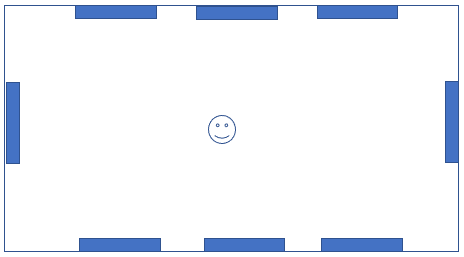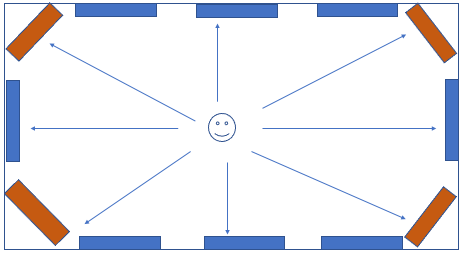As an independent content creator, the biggest problem you've probably run into is...room echo!
Yes, there are a lot of plugins that claim to “fix” the acoustic problems present in your studio (or recording space), but in our experience, they will generally trade room deficiencies for other strange audio effects (or artifacts) that are superimposed onto the main announcer's voice.
We've found that the best approach is to minimize (if not eliminate) the problem at the source...just like the pros do!
This is the next installment in our series on this topic. If you missed part one, check it out here.
Let’s discuss some common tools to address room reverb and / or echo. We're going to greatly simplify things quite a bit here for the sake of benefiting the most content creators regardless of technical background. The point here is just following the advice I’m about to give here will provide immediate results for just about any podcaster. The actual physics behind how all this works is quite deep.
#1: Acoustic Panels
Acoustic panels function by absorbing sounds at higher frequencies that would normally bounce from the wall, and back into the open room space. They serve a very similar function that the clothes hanging in a small closet studio does. Let’s examine why the clothes in a “closet studio” control echo in that space...
The clothes hanging in the closet absorb much of the sound from your voice before it strikes hard the wall surface they are in front of. The sound that makes it pass the clothing and to the wall will go on to bounce from the wall...but must then pass through the clothing in the closet again before it can make it to the open space where your microphone is.
This second pass through the clothing will further reduce the volume of (or further mute) this reverberation. And that right there is the core of what we're wanting to do.
We're trying to treat the surfaces in such a way that minimizes the amount of sound that makes it to the wall surface. The residual sound waves that do make it to the wall and bounce off it must come through that same acoustic panel again to reach the open room space.
This second pass through the panel further reduces the strength, or volume, of the sound bounce, or echo. These panels can help to “deaden” the space by reducing room reverberations.

Panels can be purchased from various vendors - typically for around $60 to $100 per panel, Or, with a little ingenuity, you can make them yourselves.
Here is one source for panels, Acoustimac. Their website is handy because of the Acoustic Panel calculator. Enter your room dimensions, the desired panel design, and it tells you about how many you'll need to treat your space.
The acoustic panels we are talking about are NOT the same as acoustic wall foam. Many try to substitute wall foam to do the job of acoustic panels. Acoustic panels (and Bass Traps -- which we will talk about next) are FAR more effective in controlling room echo than foam panels. The materials they are made of have more mass (are heavier) than wall foam , which makes it possible for them to absorb a much broader range of audio frequencies. Your clothes in the studio closet, for that matter make better acoustic “panels” than the foam ones.
Foam panels are great at light duty acoustic control, such as breaking up the bounce from the area of your work desk that attaches (or buts against) the wall. Sticking the foam on those wall surfaces works great at controlling the desk to wall echo bounce without having to resort to a huge acoustic panel. An Acoustic panel along the desk area that butts against the wall certainly does the job, but not without taking away valuable desk / work space.
If you are interested in creating your own Acoustic Panels, There are a number of YouTube videos that show you how. We have links in the show notes for you to follow to get some DIY ideas.
#2 Bass Traps
Bass Traps are every bit as important to room acoustics as acoustic panels.
The big thing with bass traps is that in most typical home studio applications, they do very little, if anything, for bass, so the generic name for them kind of misleads what a “Bass Trap” can do for your home studio. A properly designed bass trap CAN control bass reflections in a studio space engineered & designed as an ACTUAL recording studio space. But most of us don't have rooms in our homes that come anywhere close to such a situation. What bass traps CAN do for our home studio or office space studio is to control vocal sound reflections that concentrate in the 90 degree corners of the room.
For the purpose of the spoken word podcast studio, bass traps can easily be created by essentially placing acoustic wall panels over the 90 degree corners of your room. We would recommend making them twice as thick as the panels used on the side walls.

They function on the same theory as acoustic panels in that they slow down (and attenuate) sound waves that head towards the corners of the room, and also reduce the bounce back from said corners. Since these 90 degree corners tend to concentrate, and amplify echos, so having doubly thick panels for the corners will go a long way in knocking down these reflections.
#3 Room Furnishings
If you decide to use a spare bedroom as a recording space, you might get away with using very little in the way of sound treatment simply because bedrooms tend to have lots of heavy soft items in the room that will naturally absorb a lot of the room echo for you. The biggest item? The bed itself. Many people build vocal booths out of mattresses by standing them up around the microphone and speaker. It looks hilarious, but the mattresses are so dense and soft that they virtually stop sounds the speaker (or singer) makes before they make it into the general room space!
A sofa or loveseat in the room will absorb even more echo. Moving it around in the room could “tune” a troublesome “echo-ey” space in the room.
#4 Floor Carpeting
Another item that helps a lot is floor carpeting. The carpet, and the foam padding beneath it act essentially as a big acoustic panel for your floor, attenuating reflections (or bounce) that happen between the floor and ceilings, and also to some degree sound that bounces between the floor and walls.
Adding one or two acoustic panels in strategic places on the walls might all be what you need to make a carpeted / furnished spare bedroom a great recording space.
#5 Diffusers
Diffusers work by breaking up a bare wall surface, which makes any reflections from that area less“coherent”. Rather than bouncing sounds directly back towards the source, as bare drywall would, diffusers “scatter” the reflections of higher frequencies across the room.
Diffusers can “liven” up an acoustically dead space (a room without ANY echo or signature) without creating overt echos or reverberations of its own. Most podcast studios won’t need diffusers, but we thought we should mention them since you’ll probably run across them while searching for acoustic treatment panels.
For those who require higher levels of isolation from “outside” noises
If you need a space that is effectively soundproofed - which is generally what you need if you are doing long narrations, or audio books, the cheapest way to do it is by purchasing what is known as a “whisper booth”. They are a very cost effective way to have a more “soundproof” vocal recording space.
This is because one of the fundamental aspects to soundproofing a studio space generally involves the space inside the studio being built as a room within a room. This means the floors, walls, and ceiling of this studio are NOT physically connected to the structure of the house, or building, or connected by some material to “cushion” the points that do touch the outside room.
This is why actual “soundproofing” is so expensive to do, and in many cases, not possible...especially in an existing room in your house.
You can build a reasonably isolated recording in an unfinished basement space, provided you have enough ceiling clearance to properly build a “room within a room”.
Going into detail about building such spaces is beyond the scope of what we are trying to do here, but for those interested, there are many sources online that talk about this subject. Just look up acoustic “isolation booths”. Or isolated rooms for recording drum kits.
We highly recommend “Whisper Booths” for anyone needing high levels of acoustic isolation at more affordable prices than a major construction project in your home.
One of my favorite YouTube folks is “The Booth Junkie” Mike Delgaudio. He built his own vocal isolation booth out of necessity, Here is a link to his first video in that series.
Mike is a professional voiceover artist, and does a lot of DIY work on his studio spaces, and loves to show how he did it...including his own DIY Whisper booth.
If You have questions, just send them to me: cornelius at legatosonicdesign dot com.